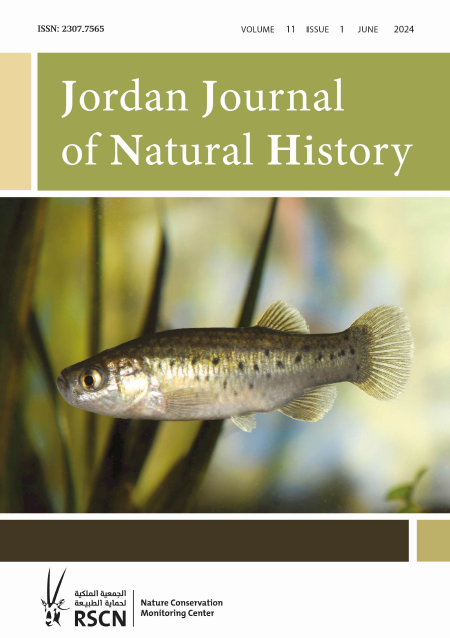Articles
Scale Insects on Ornamental Plants in Tunisia
Author Name
Monia Kamel Ben Halima, Sana Zouari, Rihem Adouani, and Zohra Ben Cheick
A survey was conducted from 2008 to 2022 in eight Tunisian coastal governorates to identify the scale insects of ornamental plants, as well as their host plants and to document their geographical distribution.
Eighteen species from four families were identified: Aonidia lauri Bouché, Aonidiella aurantii Maskell, Aulacaspis rosae Bouché, Chrysomphalus aonidum L., Leucaspis pusilla Löw, Parlatoria ziziphii Lucas (Diaspididae), Ceroplastes floridensis Comstock, Ceroplates rusci L., Saissetia olea Olivier, Coccus hesperidum L. (Coccidae), Maconellicoccus hirsutus Green, Phenacoccus peruvianus Granara de Willink, Phenacoccus madeirensis Green, Planococcus vovae Nassonov, Planococcus citri Risso, Ferrisia virgata Cockerell and Pseudococcus longispinus Targioni-Tozzetti (Pseudococcidae) and Icerya purchasi Maskell (Margarodidae). In this study, the authors reported, for the first time, L. pusilla on Pinus halepensis (Pinaceae), Coccus hesperidum on Musa sp. and the secondary host Dracenea marginata (Asparagaceae) of C. aonidum for the first time in Tunisia.
Faunistic studies are important for documenting new distributional data and notifying researchers of potential exotic pests.
Elias N. Handal1, Saed L. Al-Shomali and Shadi H. Adawi
Author Name
Four New Records of Beetles (Coleoptera) from the Palestinian Territories – West Bank
In this study, Phoracantha recurva (Family Cerambycidae), Myrrha octodecimguttata and Hyperaspis trifurcata (Family Coccinelidae) and Sitaris solieri (Family Meloidae) are reported for the first time from the Bethlehem district in the Palestinian territories (West Bank).
The State of Terrestrial and Freshwater Biodiversity in Jordan: Invertebrates (Annelida and Mollusca)
Author Name
Zuhair S. Amr
Comprehensive lists of recorded species of both phyla Annelida and Mollusca from Jordan are provided. Phylum Annelida includes three classes with a total of twentyfour species, with two new species described from Jordan. Phylum Mollusca contains forty-three species of terrestrial land snails and twenty-five species of freshwater snails.
Combating Illegal Bird Trading: The First Project for the Conservation of Alexandrine Parakeets Psittacula eupatria (Linnaeus, 1766) in Odisha, India
Author Name
Aurobindo Samal, Shreya Pandey, Devi Priyadarshini, and Subhajit Nayak
Illegal wildlife trade critically threatens biodiversity and ecosystem balance, with species like the Alexandrine Parakeet (Psittacula eupatria) being particularly at risk. This paper analyzes the global and Indian illegal bird trade, focusing on the Alexandrine Parakeet in Odisha, India. It examines the trade’s drivers and ecological impacts on wild populations using a multidisciplinary approach. The study investigates the modus operandi of illegal traders, trafficking routes, and market demand.
Highlighting of the conservation status Alexandrine Parakeets, this work underscores the urgent need for robust conservation efforts. The paper outlines the first comprehensive conservation project designed specifically for this species, which included integrating community engagement, education, habitat protection, and law enforcement to safeguard habitats and curb illegal trade. Through extensive fieldwork, capacity-building programs, and socialawareness campaigns for the youth and local communities, it provides actionable insights and recommendations for policymakers, conservationists, and law enforcement. The study ultimately aims to enhance the understanding of the challenges posed by illegal wildlife trade and propose effective conservation strategies for protecting the Alexandrine Parakeet and its ecosystem, mainly through fostering awareness among the local communities.
Screening Cactus Varieties Resistant to Cochineal Scale, Dactylopius opuntiae (Cockerell) (Hemiptera: Dactylopiidae) in Jordan
Author Name
Razan Qasqas, Ahmad Katbeh-Bader, Dajana Frasheri, Ibrahim Al-Jboory, and Sawsan Hassan
The cochineal scale, Dactylopius opuntiae (Cockerell) is a serious pest of cactus in many parts of the world. It was first recorded in the north of Jordan in 2018 and continued to spread in the country. To use environmentally safe control methods for this invasive pest, two experiments were conducted to find cactus accessions resistant to the cochineal scale. The first experiment was conducted on twenty-six accessions in a growth chamber at a temperature of 27°C ± 0.5°C and 70-80% of RH. The second experiment was conducted in the Jordan Valley and included ninety-nine accessions. All accessions were obtained from the International Center for Agricultural Research in the Dry Areas (ICARDA). Accessions from countries around the world were tested (Algeria, Argentina, Brazil, Italy, Jordan, Mexico, Morocco, South Africa, Syria, and Tunisia). All the first twenty-six accessions were found susceptible to the pest. The average duration of one generation of the insect ranged from thirty days to fortyone days with an average of 36.3 ± 2.59 days. On the other hand, out of the ninety-nine cactus accessions, four were found resistant and showed no infestation at all. These were Unknown 120 and Unknown 122 from Syria, Opuntia robusta 1280 from Argentina, and Opuntia robusta 200146 from Brazil. The most susceptible accessions were Zastron 4 and M3 Bianca di Macomer from Italy and 40-Tronzar and GS from Tunisia with an infestation rate of more than 90%.
First Record of the Lime Butterfly Papilio demoleus (Linnaeus, 1758) (Lepidoptera: Papilionidae) from Jordan
Author Name
Ahmad Katbeh-Bader
The lime butterfly Papilio demoleus (Linnaeus, 1758) (Lepidoptera: Papilionidae) is recorded from Jordan for the first time based on the identification of three specimens collected from Al Kurayyimah in the Jordan Valley during May 2024. Its biology, ecology, and distribution are briefly discussed
Morphology and Sexual Dimorphic Traits in the Scales and Fins of the Old-World Cyprinodontiform fish Aphaniops sirhani (Actinopterygii: Aphaniidae)
Author Name
Hamid Reza Esmaeili, Sorour Echreshavi and Nashat Hamidan
Sexual differences between males and females have been of special interest in the study of systematics/taxonomy, phenotypic evolution, and the farming of different invertebrate and vertebrate taxa including fishes. Sexual differentiation may be a result of natural selection, sexual selection, or a combination of the two. This study aims to examine the microscopic characteristics of scales and rays in the toothcarp Aphaniops sirhani (Cyprinodontiformes: Aphaniidae) that is endemic to Azraq wetland in northeastern Jordan. The study discusses the taxonomic and evolutionary significance of these structures and determines whether they can be used as secondary sexual dimorphism traits. The findings here indicate that the Azraq killifish males of the toothcarp have contact organs that exhibit sexual dimorphism in the form of spicule-like structures in the anal-fin rays and ctenus-like structures in the posterior margin of the scales. The contact organ variations in size, number, and location may offer a taxonomic and evolutionary signal for a deeper comprehension of the aphaniid species.
A New Record of the Sand Cat, Felis margarita, from Al-Dahek Reserve in the Eastern Desert, Jordan
Author Name
Omar Suleiman and Omar Kilani
The Sand Cat (Felis margarita) is a small sized desert felid weighing two to three kg. Sand Cats have a broad head with large eyes, low-set ears, and short limbs. The tail, which can account for about half of the head-body length or 28-38cm (Ghadirian et al., 2016), features two or three rings and a black tip. Sand Cats have dense hair and pads on the soles of their feet that protect against the intense heat and coldness of their habitat, as well as aiding in movement across the Sand. (Smithsonian’s National Zoo and Biology Institute, 2020). It is found in Sand deserts and gravel deserts ranging from the north of Africa to Asia, with the Arabian Peninsula as its central distribution area (Sausman, 1997). It is well adapted to living in arid areas and where temperature changes are extreme ranging from 0C° to 58C° (Sausman, 1997). The Sand Cat is a nocturnal, spending the days in shallow burrows or under vegetation (Ahmad et al., 2016). Its preferred prey consists of small rodents, reptiles and insects. (Abbadi, 1991; Bunnian et al., 1998; Cunningham, 2002).
The First Occurrence of Entomopathogenic Fungi Ophiocordyceps nutans in Tamil Nadu, India
Author Name
Phillmon Smart Edward, Arockianathan Samson, Jeyasubashini Regupathikannan and L. Arul Pragasan
The novel observation of Ophiocordyceps nutans infecting Erthesina fullo in Kargudi, Tamil Nadu, emphasizes the potential of entomopathogenic fungi (EPF) as natural agents for controlling pests. O. nutans is known for its host spectrum (primarily ants), which now includes a significant pest, the stink bug. This discovery highlights the complex connections in ecosystems and indicates the possibility of utilizing EPF for environmentally friendly pest control. This work suggests more research on the ecological and agricultural impacts of EPF to investigate sustainable pest management techniques and support biodiversity conservation.
The First Record of a Scalariform Shell of Metafruticicola berytensis (Pfeiffer, 1841) from the West Bank in the Occupied Palestinian Territories
Author Name
Elias N.Handal
specimen of Metafruticicola berytensis (Pfeiffer, 1841) was found in Ajoul Village in the Ramallah district in the occupied Palestinian territories – West Bank with Scalariform. This is considered the first record of this malformation for this species. This specimen was collected during a survey to study the land snail of the West Bank between 2015 and 2018 by the Palestine Institute for Biodiversity and Sustainability.




